Content
Hydrangea blooms with bright lush inflorescences and is considered one of the most beautiful and spectacular ornamental plants in the garden or in a pot on the window. This shrub plant has about 80 species, 35 of which are grown in Russia.

In natural conditions, hydrangea is found in Japan, China, Korea, Philippines, Java, North America
What year does hydrangea bloom after planting?
The plant blooms, as a rule, the next year after planting, but there is a possibility that this will happen in 2-3 years - it all depends on the care and variety. For the first time, do not expect large flowers and lush inflorescences.
If you plant it in the fall, next summer it will delight you with the first small flowers. If in the spring, then, most likely, it will bloom in the summer after a year, but with proper care, the hydrangea blooms in the first year of planting, that is, in summer-autumn.
Full bloom of hydrangeas can be expected 2-3 years after planting.
In order for the flowers to be large and pleasing to the eye as long as possible, proper care of the bush is necessary.
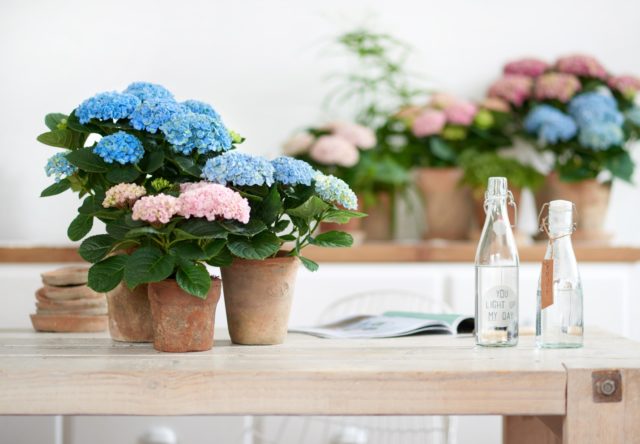
Hydrangea in pots fits well into the interior of the apartment
How many hydrangea blooms in the garden
The timing of flowering garden hydrangea depends on many factors:
- grade;
- climate and weather conditions;
- care and pruning methods.
For many decades, breeders have been working on the development of new varieties of hydrangea, therefore there is a wide variety of decorative varieties with different flowering periods - from 1.5-2 to 3-4 months. The warmer the climate, the longer flowering lasts.
The first flowers of garden hydrangea bloom in early June. Most varieties begin to bloom in July and cease in early fall - September. Some plant species delight gardeners in October.
Gardeners strive to organize continuous flowering in their area. For this, it is important to choose the right hydrangea varieties. Having planted 2 or 3 species, you can achieve a permanent holiday in the garden from early June to mid-October.
How many indoor hydrangea blooms
On the windowsill, plants have a longer flowering period than on the street. Indoor hydrangea blooms from May to late autumn.
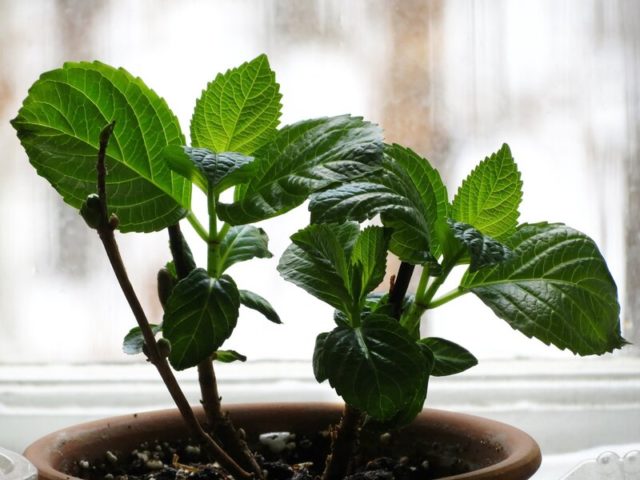
In winter, indoor hydrangea rests and accumulates strength until spring
On which shoots does hydrangea bloom
It blooms on last year's shoots or on young growths of the current year.
Last year, only one variety blooms - large-leaved. Therefore, pruning of this plant has its own characteristics: it consists in cutting off last year's inflorescences and sanitizing. If you cut the bush according to the standard pattern, it will not bloom at all. It is preferable to grow this variety in places with warm winters, since the bud, which is laid in the fall, is difficult to preserve during frosts.
The rest of the varieties bloom on the shoots of the current year and require classic pruning. They are usually hardy. Even if the shoots freeze, after pruning them in the spring, young ones with flower buds will begin to grow from the remainder.
Groundcover hydrangea also blooms on current shoots, but pruning has some differences: long branches are only slightly shortened.
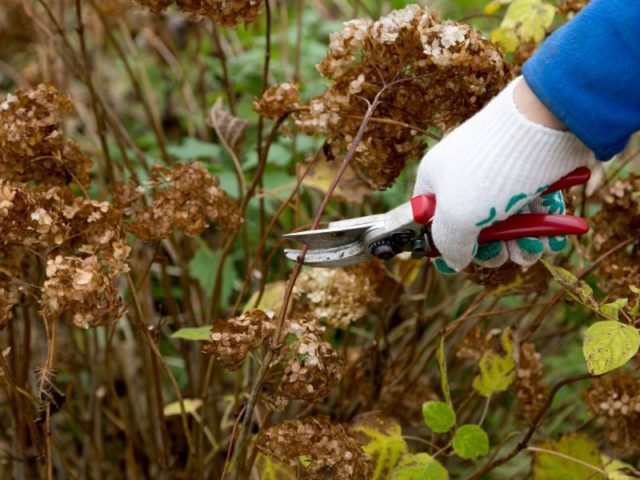
Different types of plants have their own pruning characteristics.
When the hydrangea begins to bloom
Different varieties of hydrangea have their own timing and duration of flowering. Care is of great importance - without it, you should not expect long flowering.
When hydrangea paniculata blooms
Paniculata has inflorescences in the form of wide-pyramidal buds with large (up to 2.5 cm) sterile flowers, first whitish-greenish, then pinkish, and with small white fruiting flowers.
After planting, the first flowers appear only after four years, subject to proper care. Its flowering begins in June and lasts until the very frost.
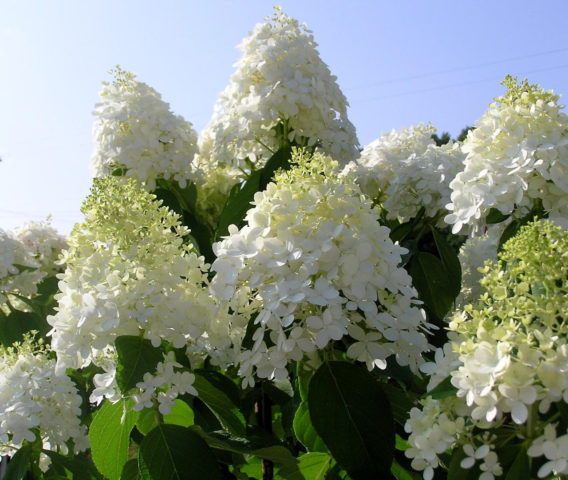
Paniculata is distinguished by large pyramidal inflorescences
When the hydrangea tree blooms
Treelike - one of the most common in summer cottages. It is a shrub 1-1.5 m high with a rounded crown and large leaves of light green color.
The first hemispheric inflorescences appear on the tops of young shoots in mid-July. At first, the flowers are greenish, then white, then greenish again. The duration of the flowering of the tree hydrangea is one and a half months. Some varieties bloom from June to October.
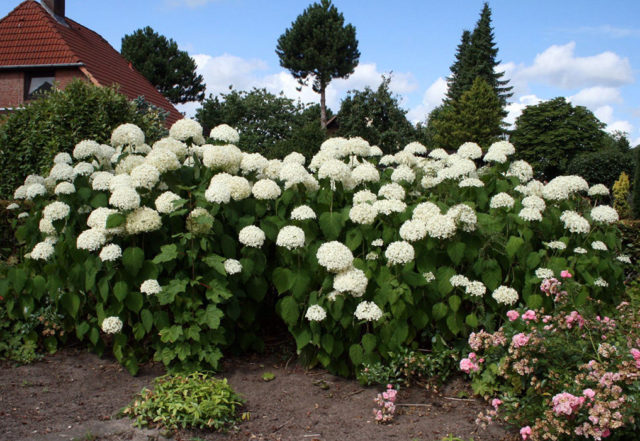
Arboreal prefers sunny areas, and less abundant flowering in shaded areas.
This species is distinguished by its unpretentiousness, is not afraid of drought, and can grow on depleted soils. The only thing is that it does not tolerate excess moisture and its stagnation.
When the garden hydrangea blooms
Garden usually begins flowering in June and ends at the end of September. On old shoots, inflorescences appear in late July or early August.
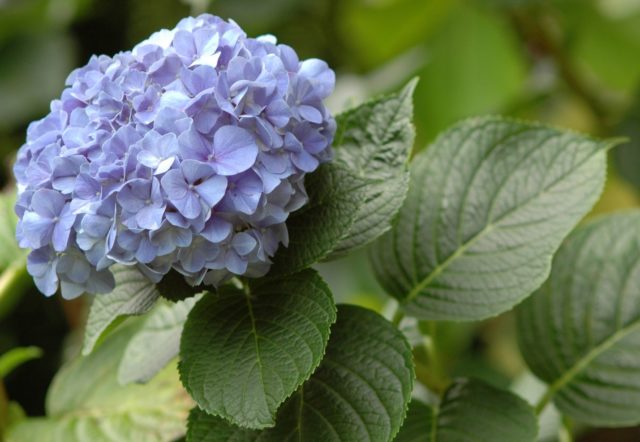
Garden hydrangea has many varieties, most of which bloom from July to September
When the petioled hydrangea blooms
Pereshkovaya is a subspecies of the garden. It is a climbing plant with delicate inflorescences and dark green shiny large leaves. The flowers are pinkish, milky white, pale purple. They gather in corymbose inflorescences that cover the entire vine. Flowers appear in mid-June and are pleasing to the eye for more than two months.
After planting, it begins to bloom on the second or third, but sometimes even later. It depends on the conditions on the site and on the lighting. The first inflorescences begin to appear on the shoots at the bottom of the plant.
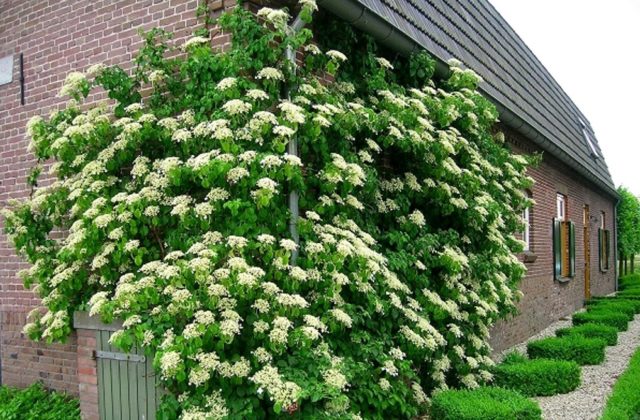
Stalked hydrangea can rise to a height of 25 m and take the form of any objects
Designers use the plant to create interesting compositions and framing various venues.
Hydrangea care tips
Hydrangea is loved for its spectacular flowering and is happily bred in a garden or in an apartment. The plant is quite unpretentious and pleases summer residents with lush caps of inflorescences from mid-summer to late autumn. To ensure abundant and long-lasting flowering, you must adhere to the rules of planting and care.
Hydrangea loves moderate sun and moist soil, while it does not tolerate stagnant moisture. The plant is planted in areas where the sun's rays penetrate in the morning and evening, and at noon they are in the shade. It is advisable not to place bushes next to large trees.
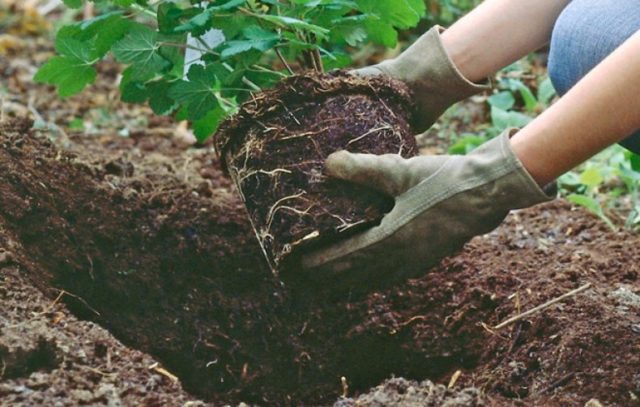
The best time to plant is spring
The plant loves humus-rich soil and does not tolerate iron deficiency. Do not plant hydrangea in limestone soil. The acidity of the soil should be between 4.5 and 5 pH. If the land on the site is not acidic enough, coniferous litter, tree sawdust, brown peat are added to the hole during planting. The infertile soil must be enriched by introducing a nutrient mixture of the following composition into the pits:
- 2 parts of humus and leafy earth;
- 1 part of brown peat and river sand.
After planting the seedling, a layer of mulch from peat and crushed bark 5 cm thick is added to the hole.
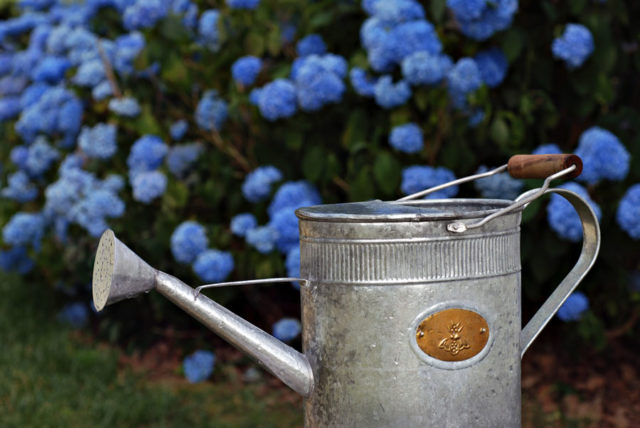
Hydrangea loves watering, but not too much
To maintain normal soil moisture, 1-1.5 buckets of water are poured under the root once a week.
In order to achieve a lush and long flowering, it is necessary to properly feed the hydrangea, otherwise the inflorescences will be small.If the bush was planted in a nutrient mixture, then the first years of life it does not need fertilization. In the future, with a decrease in flowers, it is necessary to make top dressing. It can be prepared independently: diluted in 15 liters of water, 15 g of superphosphate and potassium sulfate and 10 g of urea. From ready-made preparations, Crystalon, Agricola, Aqua are suitable. The first time the fertilizer is applied at the beginning of spring, the second - after the buds appear. For top dressing in 15 liters of water, 20 g of potassium sulfate and superphosphate are diluted. During the summer, about once every 4 weeks, hydrangea is watered with infusion of cow dung.
Another important point is the formation of a bush. Without pruning, the plant will not look spectacular. It is carried out starting from the second or third year. This is done in the spring before sap flow or at the beginning of autumn.
Each species has its own peculiarities in pruning:
- Paniculata. In the spring, young growths are pruned by 1-3 buds and shoots are removed inside the crown. Often, a bush is formed on the basis of the strongest shoot, growing it up to 1 m, removing all lateral shoots.
- Tree-like. Three-year-old branches, crooked and weakened shoots are removed. It is cut the shorter the weaker it is. In young growths, only a few buds are left.
- Large-leaved. In the spring, sanitary pruning is carried out, removing all damaged, broken, frozen shoots. Slightly pruned shoots in early autumn.
Older shrubs may require rejuvenation. It consists in a radical pruning to the stump.
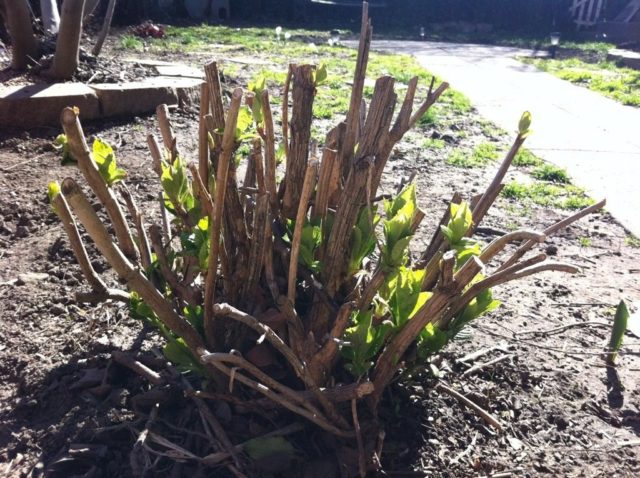
Bloom may be absent after a large pruning next year.
Some types of hydrangea, for example, large-leaved, do not tolerate cold well. Therefore, the branches are neatly bent to the ground after the leaves have fallen, spreading spruce branches under them and covering them from above. In the spring, the covering layer is removed gradually so that the hydrangea does not have stress from temperature extremes. In addition, it is advisable to make a rigid frame over the bush and cover it with film. If slugs are bred on the site, sprinkle the soil with mulch or pine needles in front of the shelter for the winter.
Paniculate and tree hydrangea tolerate wintering well. Mulching is enough to protect them.
Hydrangea must be protected from diseases and pests, although it is believed that it is quite resistant to them. Powdery mildew may appear on it, against which Bordeaux liquid is used. Aphids and other pests are fought with drugs such as Actellik and Fitoverm.
To make the indoor hydrangea bloom faster, heat baths are made - every day they put the pot with the plant in a bowl of warm water (about 37 ° C) for 10 hours. To make it bloom longer, it is better to put the bowl in a place where diffused light falls.
Conclusion
When the hydrangea blooms, the garden area is incredibly transformed. In order for it to delight the owners as long as possible, you need to choose the right varieties and follow simple rules of care.








